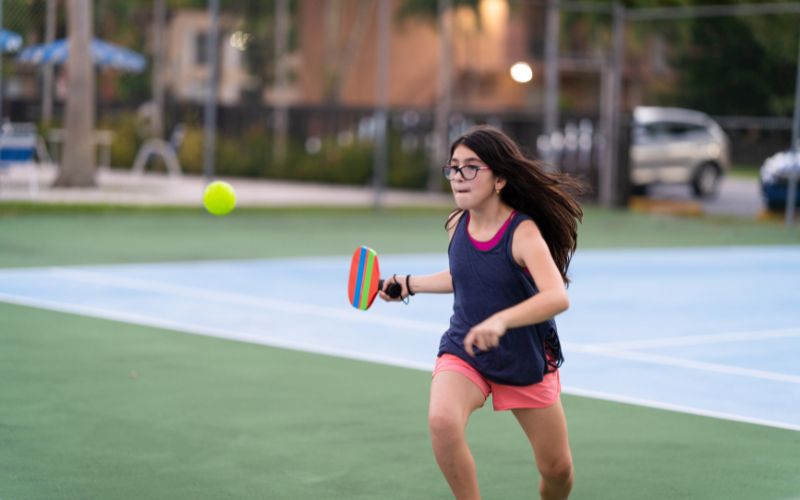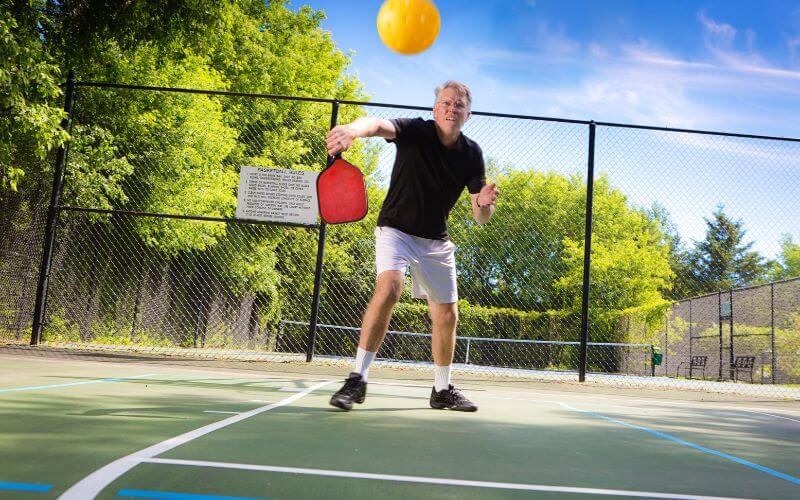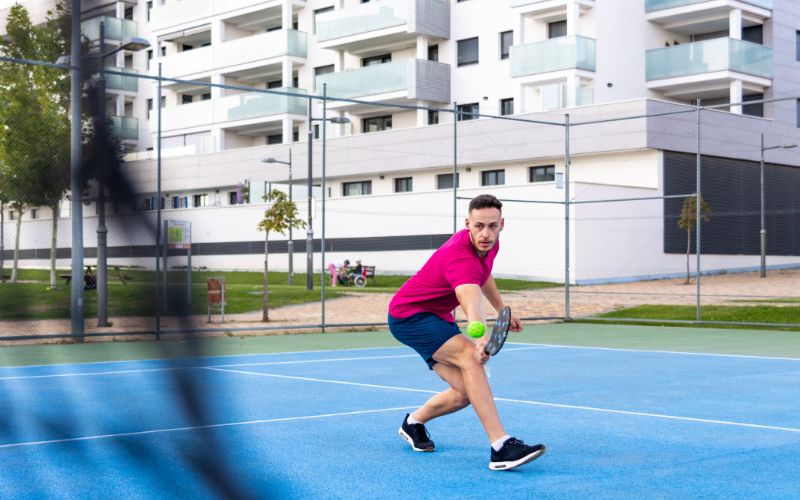Pickleball, a unique and fast-paced sport that combines elements of tennis, badminton, and ping pong, has gained tremendous popularity in recent years. Pickleball singles strategy is a crucial aspect of the game, determining the outcome of matches. In this comprehensive guide, we’ll delve into various aspects of singles play, from understanding the court dynamics to mastering specific shots and strategies.
The Basics of Pickleball Singles Play
Understanding the Non-Volley Zone (Kitchen Line)
The non-volley zone line, often referred to as the kitchen line, is a critical element in singles play. Staying behind this line is essential to avoid unforced errors and maintain better positioning. As the game progresses, keeping your opponent away from this line can limit their shot opportunities and increase your chances of success.
Mastering the Third Shot
The third shot is a pivotal moment in a pickleball rally. Aim for a controlled and well-placed shot that disrupts your opponent’s rhythm. Whether it’s a soft drop shot or a deep shot, the third shot sets the tone for the rest of the point.
Taking Advantage of Deep Shots and Passing Shots
Hitting deep into your opponent’s backhand side can force them into a defensive position. Combine this with a well-executed passing shot to exploit their weaker side. This combination can create winning shot opportunities and keep your opponent on the defensive.
Advanced Strategies for Pickleball Singles
Controlling the Center Line and Open Court Space
Positioning yourself strategically along the center line allows you to control the game’s pace. By taking advantage of open court space, you can force your opponent into awkward positions, creating opportunities to hit the ball into areas where they are less comfortable.
Analyzing and Exploiting Opponent’s Position
Understanding your opponent’s position is crucial in developing an effective singles strategy. Identify their weaknesses and exploit them by hitting shots to the side of the court where they struggle the most. Additionally, take note of your opponent’s momentum and ability to make informed shot selections.
Strategic Shot Selection and Avoiding Unforced Errors
Your singles strategy should involve smart shot selection that considers your opponent’s moves. Avoid hitting directly at your opponent unless you are confident in creating a difficult shot. Instead, aim for areas where your opponent is likely to make unforced errors, providing you with more chances to seize control of the game.
Ensure Consistent Depth in your Pickleball Serves
Consistently delivering deep serves is a vital component of effective doubles pickleball strategy. However, in the context of singles pickleball, an even greater emphasis is placed on executing powerful, deep serves. It becomes a fundamental necessity in singles play. Strive to hit commanding, deep serves that force your opponent to retreat beyond the baseline, creating a challenging and elongated return for them—ultimately setting the stage for a more manageable third shot on your end. Employing a forceful, deep serve provides you with a significant advantage right from the outset.
Nonetheless, while prioritizing a deep serve is essential, exercise caution to avoid serving out of bounds. Maintaining an ample margin for error is crucial to prevent errors in placement. Keep in mind that the serve is a shot in pickleball where precision is entirely within your control, subject only to environmental factors like wind. Through dedicated practice, strive for exceptional accuracy in your serves to enhance your overall performance on the pickleball court.
Target the “T” During Your Pickleball Serve
In singles pickleball strategy, another valuable tip related to serving involves directing your serve towards the middle of your opponent’s side of the court, ensuring it remains within the designated service box. In essence, aim to serve near the “T” on the pickleball court, situated at the intersection of the baseline and the centerline. Opting for this strategic placement reduces the number of steps required and, more importantly, minimizes the time needed to position yourself for the subsequent shot following the serve. This is attributed to the likelihood of being near the court’s midpoint while anticipating your opponent’s return. Additionally, by targeting the “T,” you limit your opponent’s capacity to execute a wide array of angles with their return of serve.
Responding to a Subpar Return of Serve
In singles pickleball strategy, emphasizing a substantial and deep return of serve is paramount. However, in instances where your return falls short, it’s crucial to understand the appropriate course of action.
When confronted with a less-than-ideal return of serve on the pickleball court, you generally confront two viable options:
- Maintain a Defensive Position at the Baseline:
- Opt to stay back at the baseline, adopting a defensive stance to regain control and re-establish yourself in the rally.
- Move Forward, Positioning Just Behind the Non-Volley Zone Line (Kitchen Line):
- Choose to advance toward the net, halting a few feet behind the Non-Volley Zone Line. This proactive approach aims to prepare for your opponent’s third shot, even after a suboptimal return. By moving in, you adopt a more aggressive stance, with the intention of minimizing the angles created by your less-than-ideal return of serve.
Determining the correct course between these two options may hinge on various factors, including your individual strengths, your opponent’s strengths, and the severity of your subpar return. It’s essential to evaluate these elements to make an informed decision that aligns with the dynamics of the match.
Prioritize Momentum Over Court Space
In many instances, the momentum prevailing in a pickleball match holds greater significance than the availability of open court space. To illustrate, envision a scenario where your opponent skillfully retrieves your exceptional shot, finding themselves positioned in the far-right corner of the pickleball court. Subsequently, they execute a powerful drive and promptly start advancing towards the center of the court, repositioning themselves to anticipate your next move.
Now, as you prepare to counter your opponent’s drive, you are presented with a choice: you can either (a) direct the pickleball into the unoccupied left side of the court, or (b) target the area on the right side where your opponent had just been standing.
While delivering shots to open court spaces is undoubtedly advantageous, there are occasions when prioritizing your opponent’s momentum takes precedence over exploiting the available court space. Arresting momentum and changing directions swiftly can be exceptionally challenging. Consequently, it is advisable to assess the trajectory of your opponent’s momentum and strategically aim your shots in the opposite direction. By doing so, you capitalize on your opponent’s inability to swiftly alter their course, potentially gaining a strategic advantage in the rally.
Allow Your Opponent to Err: A Strategic Approach
At times, pickleball players—especially those engaged in singles matches—tend to strive for excessive brilliance, attempting to secure winning shots. The drawback of relentlessly pursuing “winners” lies in the diminished margin of error, leading to an increased likelihood of making mistakes.
In singles pickleball, a viable strategy involves exerting pressure on your opponent and, intriguingly, allowing them to make mistakes. Instead of jeopardizing your own accuracy by aggressively going for “winners,” induce your opponent to falter under pressure, compelling them to deliver a subpar shot in their pursuit of a decisive point. This tactic holds particular relevance as a match progresses, especially towards its conclusion or on a critical match point. As pickleball games near their end—especially when one player establishes a noticeable lead—the player lagging behind often resorts to more audacious plays. Position your opponent in this predicament and let them be the one to commit mistakes on the pickleball court.
Fine-Tuning Your Pickleball Singles Game
Serving with Precision
The serve is a weapon in singles play. Experiment with different serves to keep your opponent guessing. A deep serve can force them into a defensive position, giving you the upper hand from the start.
Enhancing Agility and Reflexes
Incorporating cross-training into your routine can enhance your lateral movement on the court. Improved agility and reflexes can make a significant difference in your ability to reach difficult shots and maintain better court coverage.
Adapting to Your Opponent’s Playstyle
When facing different opponents, it’s essential to adapt your strategy. Analyze your opponent’s return (0/1) patterns and exploit their weaknesses. By keeping the ball away from their strengths, you can increase your chances of hitting winning shots and controlling the game.
Conclusion
In the world of pickleball singles, mastering the nuances of strategy is key to success. From the basics of court dynamics to advanced shot selection, every element contributes to your overall performance. By incorporating these strategies into your game, you can elevate your pickleball singles strategy and become a formidable opponent on the court. Remember, precision, positioning, and adaptability are the keys to mastering this exciting and dynamic sport.
Frequently Asked Questions
1. What role does the pickleball court size play in singles strategy?
Understanding the pickleball court’s dimensions is crucial in shaping your game. The court size significantly impacts movement and shot selection, emphasizing the importance of court awareness in singles play.
2. Why is serving deep in singles pickleball important?
Serving deep is essential in singles play as it puts immediate pressure on your opponent, pushing them beyond the baseline. This strategic move ensures control from the beginning and sets the stage for a more manageable third shot.
3. How does the non-volley zone (kitchen line) affect singles strategy?
Staying behind the non-volley zone line is essential to avoid unforced errors and maintain better positioning. As the game progresses, keeping your opponent away from this line limits their shot opportunities and increases your chances of success.
4. Why is prioritizing momentum over court space a strategic approach?
Momentum is often more critical than open court space. By considering your opponent’s momentum and hitting shots in the opposite direction, you can capitalize on their difficulty in stopping momentum and changing directions, gaining a strategic advantage.
5. How can I handle a subpar return of serve in singles pickleball?
When faced with a less-than-ideal return, you have two options: stay back at the baseline defensively or move forward just behind the non-volley zone line to prepare for your opponent’s third shot. The decision depends on your strengths, your opponent’s strengths, and the severity of your subpar return.





